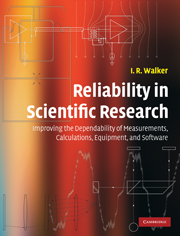 Reliability in Scientific Research
Reliability in Scientific Research Published online by Cambridge University Press: 05 June 2012
Introduction
The following chapter discusses a number of important issues that affect many classes of experimental hardware. For instance: vibrations can cause problems with optical, cryogenic, and other apparatus, and overheating may afflict electronic instruments, computers, and numerous other items.
Stress derating
The practice of derating (otherwise known as “providing a margin of safety”) is a means of improving the reliability of devices exposed to physical stresses (including power, temperature, electric current, pressure, etc.). If devices are operated continuously at their rated maximum stress levels, they are not unlikely to undergo failure in a relatively short time. Derating consists of operating them at reduced stress levels, at which the probability of failure is comparatively small. The derating factor of a device is usually expressed as a ratio of the stress needed to achieve good reliability to the rated maximum stress. While the term “derating” is normally used in conjunction with electrical and electronic components, the principle is a general one.
Generally, systems comprising a collection of components (e.g. a power supply or a power amplifier) are not derated as a whole, because derating has (or should have been) already been done for each of the constituent components. That is, derating is usually done at the component level, rather than the system (collection of components) level. (An exception is the temperature derating of power supplies – see below.)
To save this book to your Kindle, first ensure [email protected] is added to your Approved Personal Document E-mail List under your Personal Document Settings on the Manage Your Content and Devices page of your Amazon account. Then enter the ‘name’ part of your Kindle email address below. Find out more about saving to your Kindle.
Note you can select to save to either the @free.kindle.com or @kindle.com variations. ‘@free.kindle.com’ emails are free but can only be saved to your device when it is connected to wi-fi. ‘@kindle.com’ emails can be delivered even when you are not connected to wi-fi, but note that service fees apply.
Find out more about the Kindle Personal Document Service.
To save content items to your account, please confirm that you agree to abide by our usage policies. If this is the first time you use this feature, you will be asked to authorise Cambridge Core to connect with your account. Find out more about saving content to Dropbox.
To save content items to your account, please confirm that you agree to abide by our usage policies. If this is the first time you use this feature, you will be asked to authorise Cambridge Core to connect with your account. Find out more about saving content to Google Drive.